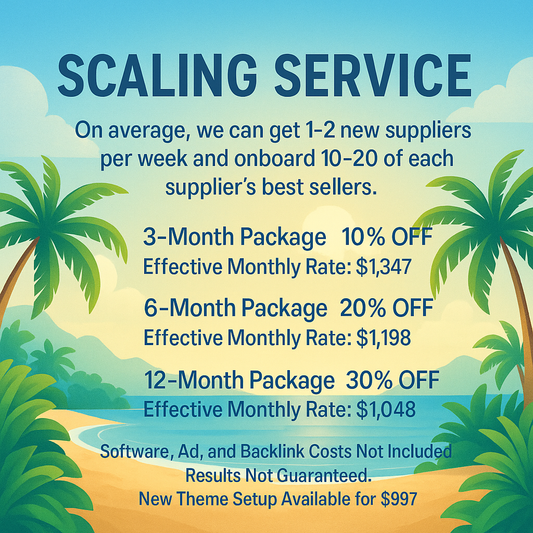
Boost Your Search Visibility with Schema Markup
Hey there, fellow ecommerce enthusiasts! Trevor Fenner here, the founder of Ecommerce Paradise. If you're looking to enhance your search visibility and take your ideal customer journey up a notch, then you’ve come to the right place. One of the most powerful yet underutilized tools out there is schema markup. Today, I'm diving deep into the ins and outs of schema markup and how it can boost your SEO efforts, especially for Google Shopping Ads, email marketing, and your overall ecommerce SEO strategy.
What is Schema Markup?
Schema markup is a type of structured data that helps search engines better understand the content of your webpage. Think of it as the hidden language of the web that can make your rich snippets stand out in search results. With the right schema markup, you can provide search engines with context about your products, reviews, ratings, and even your business's geographical information.
In today's competitive ecommerce landscape, understanding and utilizing schema markup can be a game-changer. Not only does it enhance your site's relevance in search engine results pages (SERPs), but it also improves your overall user experience. Let’s break down the main benefits:
Why Use Schema Markup?
- Enhanced Visibility: Schema markup displays additional information in search results, like star ratings, price, and stock levels.
- Higher Click-Through Rates: Eye-catching snippets lead to higher CTR as potential customers are more likely to click on listings that provide more details.
- Voice Search Optimization: With the rise of voice searches via virtual assistants, schema markup helps in delivering precise answers that users are looking for.
- Better Content Recognition: By structuring your data, search engines can better categorizes your content and serve it to the right audience.
Types of Schema Markup for Ecommerce
When it comes to ecommerce, there are various types of schema markups that can give you a competitive edge in SEO. Here are the most relevant ones to consider:
Product Schema
This one is a must-have for any online store. Product schema markup helps you highlight specific details about your products such as:
- Name
- Description
- Price
- Availability
- Review Ratings
By utilizing product schema, customers searching for your goods are more likely to find you on Google Shopping Ads, thanks to the detailed information presented in a visually appealing format. Yes, it’s as powerful as it sounds!
Review Schema
If you’re a fan of customer feedback—and you should be—review schema markup is your friend. This allows you to showcase real customer reviews and ratings directly in search results. Just imagine seeing your star ratings visible right under your product listings. This can significantly boost consumer trust and drive conversions.
Breadcrumb Schema
Breadcrumb schema helps to simplify website structure. When users can see their path back to the main categories of your site from a product page, it enhances usability. This not only aids in navigation but also sends search engines clearer signals about your content hierarchy, improving your ecommerce SEO.
Organization Schema
Using organization schema gives you a chance to provide crucial information about your business. This includes your company's name, logo, and contact details. This can further enhance brand recognition and can be extremely beneficial for local SEO if you operate a physical store alongside your online store!
How to Implement Schema Markup
Alright, by now you’re probably wondering, “How do I actually implement this?” Fear not; I’ll break it down for you! Implementing schema markup may sound intimidating, but it’s totally doable.
1. Choose the Right Schema Markup Format
You have a few options for implementing schema markup: JSON-LD, Microdata, and RDFa. JSON-LD is widely recommended and is a bit easier to implement, as it allows you to keep your markup separate from your HTML.
2. Use Google’s Structured Data Markup Helper
This is a free tool that makes the process simpler. You can select a type of schema and then just highlight the information on your webpage that you want to mark up. Google will generate the code for you!
3. Add the Schema Markup to Your Site
Once you have your structured data, you’ll need to add it to the appropriate pages of your Shopify store. Most of the time, this would involve inserting the code in either the theme.liquid file or your product templates.
4. Test Your Schema
Before you hit the "go" button, always test your schema markup with Google’s Rich Results Test. This will help you troubleshoot any potential errors to ensure your structured data is implemented correctly.
Benefits for Google Shopping Ads
During the journey of increasing your search visibility, it’s impossible to ignore the role of Google Shopping Ads. Schema markup enhances your product’s presence across all channels, and this includes Google Shopping Ads. With attractive and informative snippets driven by structured data, your ad becomes more appealing to potential customers. This translates directly to higher click-through rates and ultimately better ROI on your advertising spends.
Combining Schema Markup with Email Marketing
While schema markup primarily focuses on search visibility, it can also be a vital tool in your email marketing strategy. Some email clients support schema for rich snippets as well. Integrating schema into the emails you send can help your emails stand out in the inbox and drive higher engagement rates from your audience.
You can use schema to display product recommendations, featured sales, and even add customer reviews right into your email. Imagine your customers receiving a visual representation of the products you’re marketing—now that’s bound to grab their attention!
Enhancing Your Ecommerce SEO Strategy
As you can see, implementing schema markup is a foundational element of a solid ecommerce SEO strategy. It can help drive organic traffic to your store, supports marketing campaigns across various channels, and enhances the user experience on your site. Whether you’re dropshipping or selling your own products, schema markup can be your secret weapon in standing out amongst the competition.
Stay Ahead of the Competition
The world of ecommerce is always evolving, and with that comes the constant need to adapt our strategies. Schema markup might seem like a minor detail in the grand scheme of things, but building a comprehensive schema strategy can notably elevate your online presence. As a business owner, it's necessary to stay ahead of your competitors, and utilizing schema markup effectively is a surefire way to keep your ecommerce SEO game on point. Let your competitors struggle with obscurity while you bask in the limelight of enhanced visibility!
Your Next Steps
It’s time to roll up your sleeves and dig into schema markup. The first step is to assess your current pages to find opportunities for structured data implementation. Take the plunge, experiment with schema, and watch as your search visibility and conversions soar. Learning about and leveraging schema will not only enhance your ecommerce SEO but also unify your approach across Google Shopping Ads and email marketing campaigns. So let's go out there and make your ecommerce dream a reality!
Here’s to your newfound visibility and success in the ecommerce world! Cheers!


















